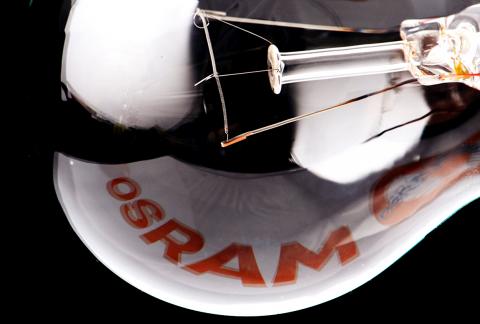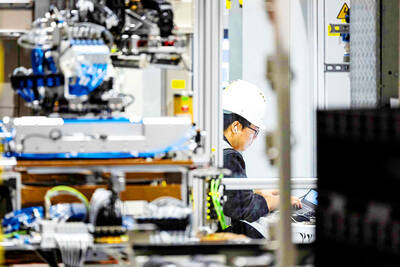Siemens AG announced plans to eliminate an additional 4,700 jobs at its Osram lighting unit after it injected 699 million euros (US$908 million) in capital to the subsidiary it is preparing to spin off next year.
The job cuts, primarily outside Germany, come on top of 1,900 positions that Osram already reduced in fiscal year 2012 and will help reap 1 billion euros (US$1.3 billion) in cost savings as the market for traditional light bulbs shrinks, the company said on Friday in a statement.
In total, the job losses at Osram will amount to about 7,300 positions. The measures will cost a “mid-three digit million figure” through 2014, with the savings realized in full a year later.

Photo: AFP
Siemens said this week that it would spin off Osram next year and retain about a fifth of the company, after realizing that investments to keep pace in the lighting market would be too great for the engineering company to shoulder. Siemens trails Royal Philips Electronics NV in the market for lighting, which is tilting toward LED technology based on semiconductors.
“Personnel increases in the future fields will only partially compensate for the change in the traditional businesses,” Osram chief executive officer Wolfgang Dehen said in the release. Osram had about 39,000 employees as of Sept. 30.
The majority of roles will be lost by selling factories abroad, mainly smaller plants or facilities making products that have reached the end of their life cycle, Osram said.
In Germany, three sites will be affected, including in Berlin and Munich, where Siemens is based. Of the planned savings of 1 billion euros, about 25 percent will be staff related, while the majority will come from lower purchasing costs and productivity gains, Osram spokesman Constantin Birnstiel said.
Siemens estimates the total lighting market will grow by about 5 percent each year to 2016, with LED market volume to quadruple by then to 37 billion euros, according to figures compiled by McKinsey & Co. The market for traditional lighting products will fall by 15 percent in that time, the data show.
Both Siemens and Philips have sought to push into the LED market, with Siemens opening a plant in China that will eventually employ 1,700 people.
Philips, based in Amsterdam, has also deepened job cuts at lighting facilities, and the company announced reductions at a factory in Belgium this month.

CHIP RACE: Three years of overbroad export controls drove foreign competitors to pursue their own AI chips, and ‘cost US taxpayers billions of dollars,’ Nvidia said China has figured out the US strategy for allowing it to buy Nvidia Corp’s H200s and is rejecting the artificial intelligence (AI) chip in favor of domestically developed semiconductors, White House AI adviser David Sacks said, citing news reports. US President Donald Trump on Monday said that he would allow shipments of Nvidia’s H200 chips to China, part of an administration effort backed by Sacks to challenge Chinese tech champions such as Huawei Technologies Co (華為) by bringing US competition to their home market. On Friday, Sacks signaled that he was uncertain about whether that approach would work. “They’re rejecting our chips,” Sacks

It is challenging to build infrastructure in much of Europe. Constrained budgets and polarized politics tend to undermine long-term projects, forcing officials to react to emergencies rather than plan for the future. Not in Austria. Today, the country is to officially open its Koralmbahn tunnel, the 5.9 billion euro (US$6.9 billion) centerpiece of a groundbreaking new railway that will eventually run from Poland’s Baltic coast to the Adriatic Sea, transforming travel within Austria and positioning the Alpine nation at the forefront of logistics in Europe. “It is Austria’s biggest socio-economic experiment in over a century,” said Eric Kirschner, an economist at Graz-based Joanneum

BUBBLE? Only a handful of companies are seeing rapid revenue growth and higher valuations, and it is not enough to call the AI trend a transformation, an analyst said Artificial intelligence (AI) is entering a more challenging phase next year as companies move beyond experimentation and begin demanding clear financial returns from a technology that has delivered big gains to only a small group of early adopters, PricewaterhouseCoopers (PwC) Taiwan said yesterday. Most organizations have been able to justify AI investments through cost recovery or modest efficiency gains, but few have achieved meaningful revenue growth or long-term competitive advantage, the consultancy said in its 2026 AI Business Predictions report. This growing performance gap is forcing executives to reconsider how AI is deployed across their organizations, it said. “Many companies

France is developing domestic production of electric vehicle (EV) batteries with an eye on industrial independence, but Asian experts are proving key in launching operations. In the Verkor factory outside the northern city of Dunkirk, which was inaugurated on Thursday, foreign specialists, notably from South Korea and Malaysia, are training the local staff. Verkor is the third battery gigafactory to open in northern France in a region that has become known as “Battery Valley.” At the Automotive Energy Supply Corp (AESC) factory near the city of Douai, where production has been under way for several months, Chinese engineers and technicians supervise French recruits. “They